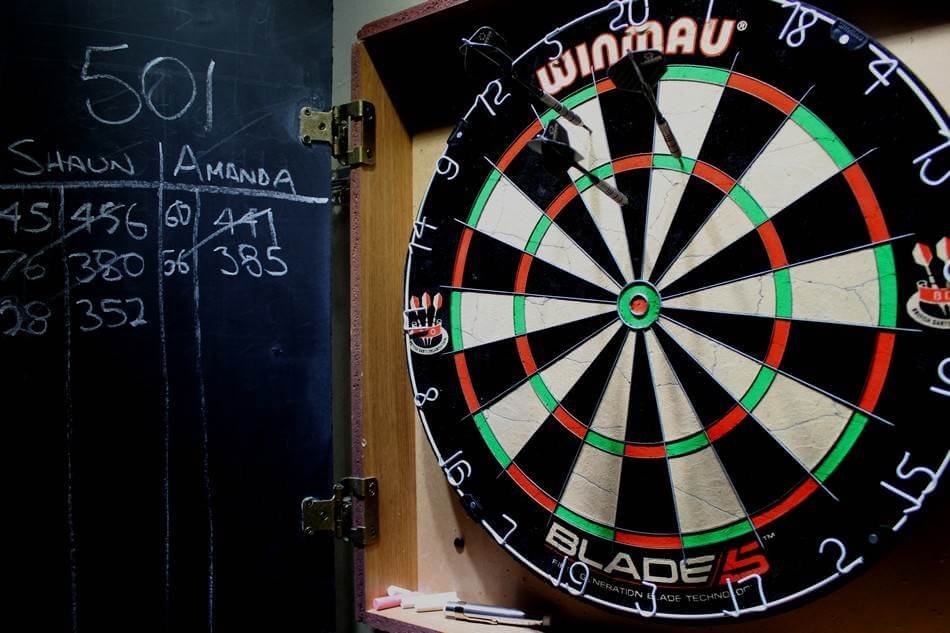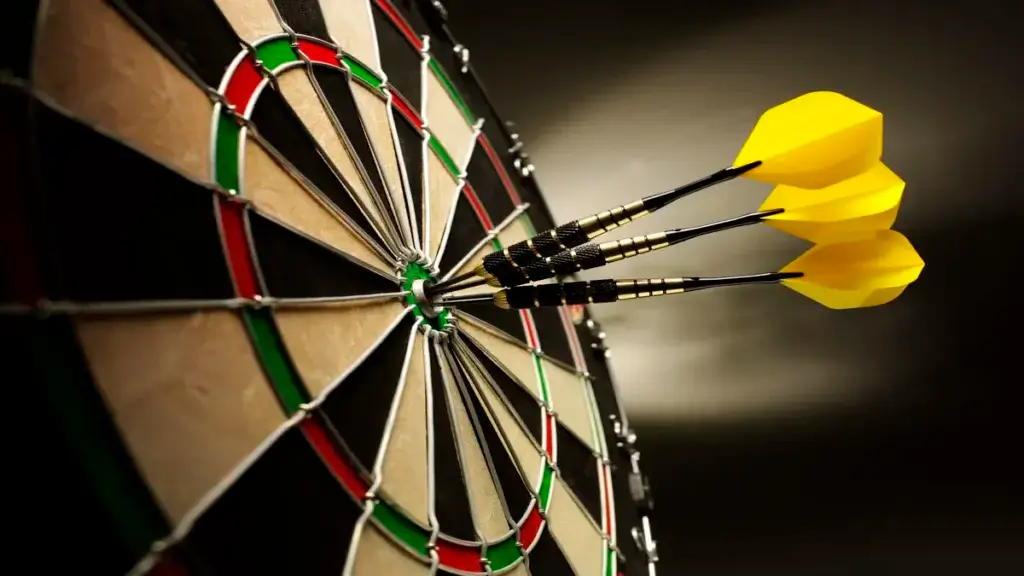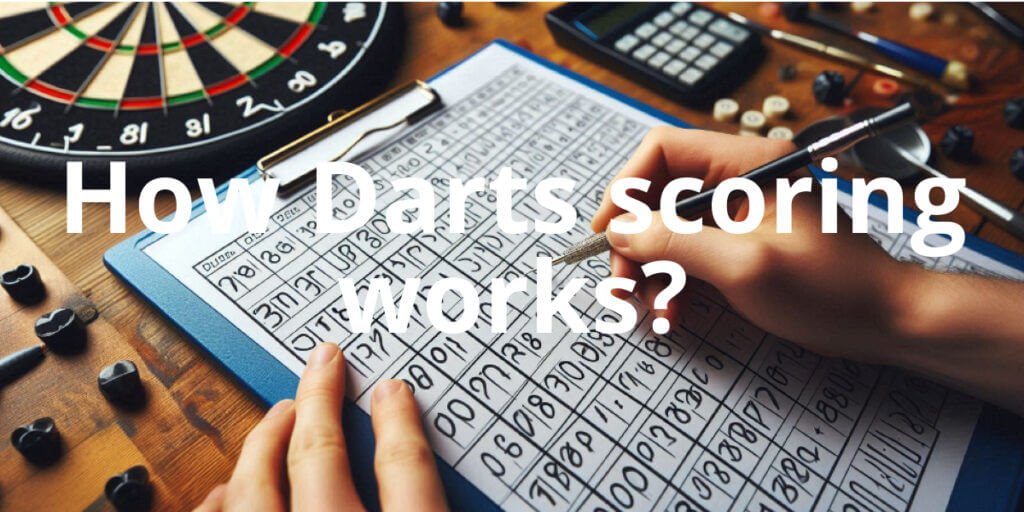If you’ve ever played a game of darts or watched a professional match, you’ve likely noticed that most of the games of darts start at 501 points.
This might seem like an arbitrary number, but there’s a historical and strategic reason behind it. In this article, we’ll explore why darts games commonly begin with 501, how it influences gameplay, and why this seemingly odd number has not changed.

The 501 format is the most popular version of the game, especially in professional settings. Now-a-days every tournament features the 501 points format. Each player starts with a score of 501 points and takes turns throwing three darts per round.
The goal is to reduce your score to exactly zero. However, there’s a catch: players must finish the game by hitting a double (the outer ring of any number or the bullseye). If a player throws too many points, also known as goes bust – he has to try again with his next visit.
1. Why Do Darts Start at 501?
To understand why the game starts at 501, we need to look at both its historical roots and its strategic impact on gameplay.
A Balance Between Skill and Duration
The 501 format offers a perfect balance between skill and game length. If games started at a lower number, such as 301 or 201, skilled players would finish the game too quickly, making matches less exciting. On the other hand, starting with a much higher number, like 1001, could result in overly long games that become tedious for both players and spectators.
With a start like 301 or 201, it would make scoring doubles more important as well – so players who like to put up high averages would lose their edge. Vice a versa if the legs would start from 1001, the scoring power would be far more important then how good you are at doubles.
By starting at 501, the game is long enough to be competitive and interesting, but short enough to avoid dragging on, especially in tournaments or league matches. The number of throws needed to reduce the score to zero allows for moments of tension, skillful comebacks, and high-pressure finishes.
Odd Number for Strategic Play
Unlike 500, the number 501 is odd, which means the game cannot be won with just hitting 20 over and over again until you have a double (or some other even number). This forces players to think more strategically as they approach their finishing shots and how they want to set up the double for ending the game.
The odd number also creates an added layer of challenge, requiring players to make quick mental calculations and choose the most efficient combination of darts to reach exactly zero, often from awkward scores like 137 or 63. Overall it adds a bit more complexity to the darts game.
Encouraging Precision with the Double-Out Rule
In the 501 format, players must finish the game by hitting a double to end the game — this is known as the double-out rule. The double-out makes the game more challenging, as even when a player is close to zero, they must hit a precise double to win.
This rule adds drama to matches, as many games can turn in a single round if a player fails to hit their double, giving the opponent a chance to catch up. The requirement to finish with a double makes sure you have to have a steady hand at the end of the leg also, not just win outright with a high-scoring power.
2. The Origins of 501
While it’s difficult to pinpoint the exact moment when the 501 format became standard, darts has a long history in pubs across the UK, dating back to around 1860´s – to read more about the origin story head over to darts wikipedia page. Early pub games of darts often involved much lower starting scores (like 301), the games were shorter and people played it just for fun while drinking with their friends.
But as the game gained popularity and began to be played competitively, starting with 501 became more common. The introduction of the double-out rule and the odd starting number added a level of strategy that made the game even more engaging for players and spectators alike.
By the mid-20th century, 501 had cemented its place as the most popular format in competitive darts. The combination of the game’s balance, strategy, and suspense, along with the growing professionalism of the sport, helped solidify 501 as the standard for both casual and professional play.

3. 501 Compared to Other Darts Formats
While 501 is the most popular darts format, it’s not the only one. Here are a few other formats and how they compare:
- 301: A quicker version of the game, with each player starting at 301 points. Like 501, players must finish on a double. This version is often used in casual settings or for quicker matches. it puts more emphasis on the importance of double out instead of average scoring.
- 701 or 1001: In these formats, players start with a higher score (701 or 1001 points). These formats are used in team matches or in longer, more endurance-based games. However, they are less common in solo competitive play due to their length. Also, this format is usually not as exciting – players with high averages get far too many chances to check out with the double so the opponent is helpless.
- Cricket: Cricket is a popular alternative game in which players must “close” certain numbers on the board, rather than simply reducing their score to zero. It’s often played in more casual settings or in specific dart leagues. Cricket is altogether a different game with different strategies – to read more about cricket head over to our article!
Compared to these other formats, 501 stands out because it offers an ideal balance of skill, strategy, and game length. It’s long enough to allow for competitive back-and-forth gameplay, but short enough to keep players and spectators engaged.
4. Strategy in 501 Darts
The starting score of 501 also invites a great deal of strategic depth. Players must consider several factors as they reduce their score, particularly when it comes to the final stages of the game:
- Scoring Efficiently: Players aim to score high early in the game, often focusing on the treble 20 (which scores 60 points) to reduce their score quickly. Hitting three treble 20s gives a perfect score of 180, the highest possible in a single round.
- Setting Up a Double: As players near the end of the game, the focus shifts from scoring high to setting up an easy finish. For example, if a player’s score is 40, they’ll aim for double 20 to finish. Skilled players are adept at maneuvering their score to leave themselves on a common double, like 32 or 40. These doubles give the best alternatives once you hit a single instead of a double as well.
- Avoiding Busts: If a player accidentally reduces their score to less than zero or fails to hit a double when their score reaches 1, they “bust” and their score reverts to what it was at the beginning of the round. This adds extra pressure to finish precisely – this also makes sure that high scoring power is not everything in the game of darts!
5. Final Thoughts on why Darts start at 501
Starting a darts game at 501 may seem like a quirky tradition, but it plays a crucial role in shaping the game’s strategy, balance, and excitement. The odd number, combined with the double-out rule, keeps players engaged and challenges them to think carefully about every throw.
Whether you’re a casual player or an aspiring pro, understanding why darts starts at 501 will give you greater insight into the game’s strategy and its enduring appeal. Do make sure you can make that 501 dissapear as fast as possible check out our best practice games!
Next time you step up to the oche, you’ll know that there’s a long history and strategic depth behind that starting score!





